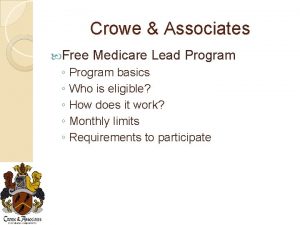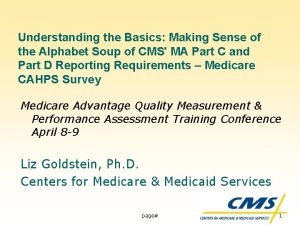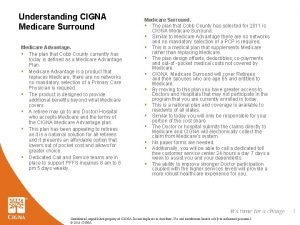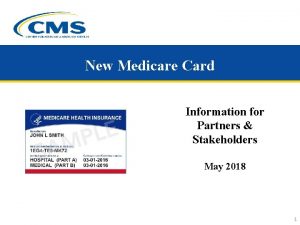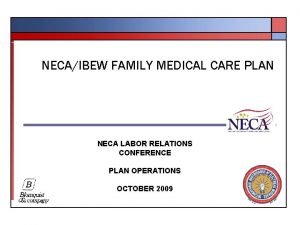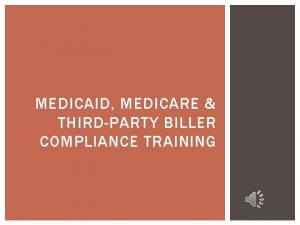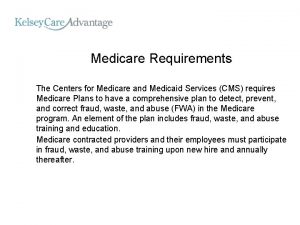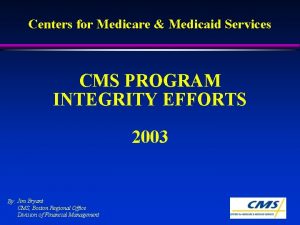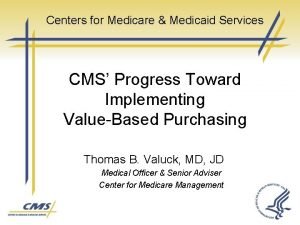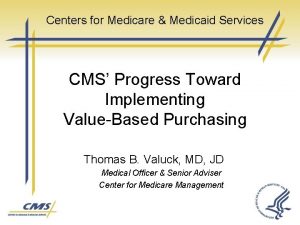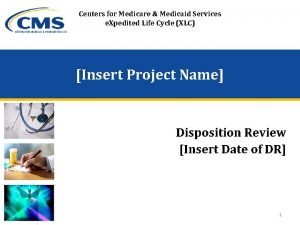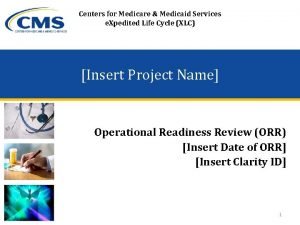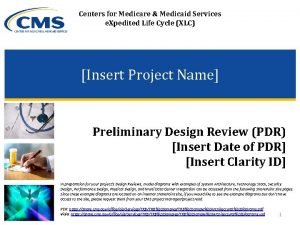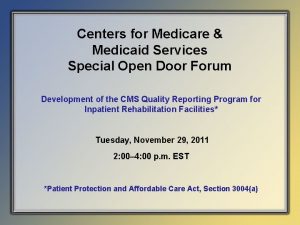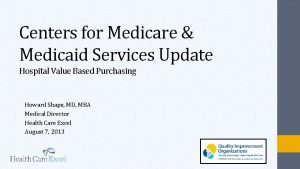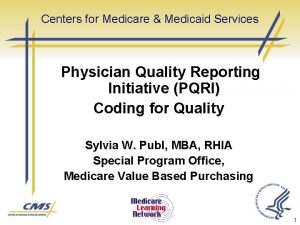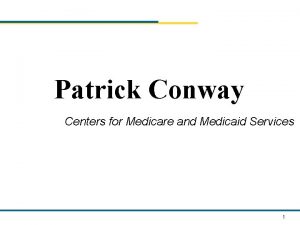Centers for Medicare Medicaid Services Center for Program

















- Slides: 17

Centers for Medicare & Medicaid Services Center for Program Integrity (CPI) Electronic Medical Documentation Interoperability (EMDI) Program EMDI Overview 2017 Document Number: EMDI-047 -EMDI_Overview-v 2. 0

Electronic Medical Document Interoperability (EMDI) Program In support of the HITECH Act, the Centers for Medicare & Medicaid Services (CMS) is committed to improving health data exchange and overall data quality, resulting in improved patient care. CMS has prioritized addressing the key challenges and barriers currently experienced by health industry stakeholders: improving the electronic medical interoperability and the adoption of Electronic Health Records. CMS has initiated the Electronic Medical Documentation Interoperability (EMDI) program, which engages key healthcare stakeholders like hospital systems, physicians, and vendors in the advancement of interoperability-related sending and receiving of electronic medical records between hospitals, physicians, labs, and vendors. Desired EMDI Process For more details, please visit https: //oncprojectracking. healthit. gov/wiki/display/Tech. Lab. SC/MRII+Provider-to-Provider 1

Presentation Assumptions • This presentation will follow a patient who requires Home Health Agency (HHA) services. § All EMDI transactions for Durable Medical Equipment, Prosthetics, Orthotics, Supplies (DMEPOS) and lab-related services will be identical to the HHA process. • Each Hospital and HHA is expected to have associated organizations, including their Document Interface Vendor (DIV) and Document Transfer Vendor (DTV). 2

EMDI Current Status 3

Electronic Medical Document Interoperability (EMDI) Program Use Cases The EMDI Program has designed three use cases to promote provider-to-provider communications in the healthcare environment: 1. Use Case 1 (UC 1): Order • A hospital sends a referral containing an order and other needed medical records documentation to an HHA. • The HHA decides whether to accept or reject the order/referral. The HHA communicates this decision back to the hospital. 2. Use Case 2 (UC 2): Request for Medical Documentation • The HHA requests medical documentation from the hospital. • The hospital sends documentation to the HHA. 3. Use Case 3 (UC 3): Request for Signature • The HHA sends a document requiring a physician signature to the hospital and requests that the ordering physician sign, date, and return the document. • The hospital sends the signed/dated document to the HHA. 4

Electronic Medical Document Interoperability (EMDI) Program Assumptions The EMDI Program Use Cases assume that: 1. A physician/practitioner at the hospital has already written the order for HHA services in the Electronic Health Record (EHR) system. 2. A discharge planner or other personnel at the hospital has spoken with the patient/family and chosen to use the HHA. In other words, a provider directory or other mechanism for one provider to discover another provider is outside the scope of this EMDI Implementation Guide and Pilot. 3. Certain business rules and validation steps may be pertinent to organizations’ specific policies, procedures, and security and compliance requirements that are outside the scope of this document. 5

Meet the Patient 6

Today’s Workflow: HHA Ordered at Hospital Discharge 7

Today’s Workflow: HHA Ordered at Hospital Discharge 8

Today’s Workflow: HHA Ordered at Hospital Discharge Mail and Fax solutions do not provide a user interface that is integrated into the Hospital’s and Home Health Agency’s (HHA) daily workflows. Documents are not sufficiently structured or standardized and thus are not fully computable when they are accessed or received. This process is slow, expensive, and requires several manual steps on both sides while providing no usable data for the recipient to 9 act upon.

EMDI Program Agnostic Standards Approach 10

EMDI Program Implementation Guide The EMDI Implementation Guide is intended to be implemented by the Hospital and/or Physician and the Home Health Agency (HHA) as well as their associated organizations. 11

New EMDI Workflow: HHA Ordered at Hospital Discharge 12

New Workflow Benefits: HHA Ordered at Hospital Discharge The EMDI Program Agnostic Standards Approach utilizes and fills the gaps in the current standards to achieve an increased level of interoperability among systems and organizations. This results in a decreased improper payment rate, minimized claim appeals, reduced administrative burden for providers, and improved provider-to-provider communication. 13

EMDI Program Agnostic Standards Approach: Direct Value for Hospitals and HHAs • Improve quality of care – o Faster communication, accurate document sharing, and elimination of redundant processes may improve quality of care for patients. • Reduce readmission rate – o Improved communication may lead to better patient care and contribute to lower readmission rate caused by delays in service. • Improve Revenue Cycle ROI by – o Reducing the readmission rate, thus avoiding the penalty caused by Medicare’s Readmissions Reduction program. o Reducing errors with electronic and standardized data exchange, leading to savings in costs of corrections. o Reducing waste of a hospital's material and staff resources. o Decreasing paper, fax, and mail costs. o Minimizing the labor time required for manual work (e. g. , redirecting documents to appropriate personnel). o Reducing the number of unanswered mail/fax. o Eliminating the delays in responding to mail/fax. o Improve market share by: o Gaining competitive advantage over those who stick to using traditional methods of fax and mail. o Increasing patient satisfaction with better provider to provider communication. 14 o Patients expect higher quality of service and more value per cost.

How EMDI Integrates and Collaborates to Improve Healthcare Standards 15

Comments or Questions? 16
 Shiba rainbow chart
Shiba rainbow chart Weathermen apush
Weathermen apush Medicare set-aside flow chart
Medicare set-aside flow chart Medicare preventive services quick reference
Medicare preventive services quick reference National medicare training program
National medicare training program Crowe and associates
Crowe and associates Medical transportation management rhode island
Medical transportation management rhode island Ny medicaid ehr incentive program
Ny medicaid ehr incentive program Wake county human services community services center
Wake county human services community services center Medicare phonetic alphabet
Medicare phonetic alphabet Is cigna a medicare plan
Is cigna a medicare plan Trailblazer medicare
Trailblazer medicare Refeeding syndrome electrolytes
Refeeding syndrome electrolytes Us medicare card
Us medicare card Planneca
Planneca Molina healthcare eligibility washington
Molina healthcare eligibility washington New medicare card poster
New medicare card poster Ivr conversion tool novitas
Ivr conversion tool novitas





